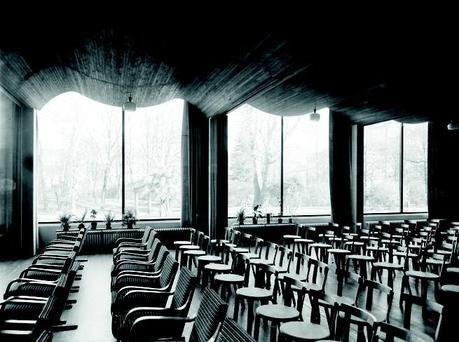
Viipuri (Vyborg) City Library, Vyborg, Karelia (today Russia), Alvar Aalto, 1927--1935
On of Aalto's first major works -- a commission he won as part of a contest -- this building is a famous example of functionalist architecture. The most influential facet of Aalto's design for the Viipuri City Library was the famous wavy wooden ceiling, a snaking set of slats made from Karelian pine and based on studies of acoustic waves. Along with the use of skylights to refract natural light, the roof helps to create an improved environment for study and contemplation.
© Alvar Aalto Museum
Image courtesy of Gustaf Welin, VG Bild-Kunst, Bonn, 2014.From the curved exterior of the Baker House dorm, a bendy straw that rethought campus construction, to the Savoy Vase, a glass creation so abstract that it was originally called eskimoerindens skinnbuxa (Eskimo woman’s leather pants), Finnish designer and architect Alvar Aalto redefined shape and space. Jochen Eisenbrand, chief curator of the Vitra Design Museum and the organizer of the museum’s new exhibition about his career, wants people to rethink the origins of these influential and experimental forms.
“People often think the shapes are a result of him being in nature, an environmental determinism or sorts,” says Eisenbrand. “We want to challenge this with images of Leger, Arp and Calder. We want to say the notion of these abstract natural forms was strongly mediated by his preoccupation with contemporary art.”
Up through March 1, 2015, "Alvar Aalto: Second Nature" seeks to expand the understanding of his career. Its natural to make the connection between his work and organic forms. Consider how his blockbuster design for the Finnish Pavilion at the 1939 World’s Fair, as well as the Scandinavian showcases at the Milan Triennale, pushed the concept internationally. But he was engrossed in contemporary art and culture, according to Eisenbrand, a collector of modern art, friend to Lazlo Moholy-Nagy, and such a film fanatic that he went so far as to design a cinema, an outgrowth of his engagement with avant-garde movies and role in a Finnish film club. In addition to examining the furniture and architecture projects he’s known for — delving into the ways the Baker House project exemplified mass individuality by providing unique views for each room — his engagement with contemporary culture and an array of lesser-known commissions and projects are on display. Plans for an art museum in Tehran and a unique plywood, leather and bent steel chair from the Paimio Sanatorium project are among the rare pieces and projects being showcased.
“He was someone who was able to merge vernacular ideas with very universal ideas,” says Eisenbrand. “Another thing we can just touch on in the exhibit is how political developments influenced his career. The fact that Finland had just become independent and sought to define itself as a western country played a role in [Aalto] examining and drawing from a universal western architectural history.”
